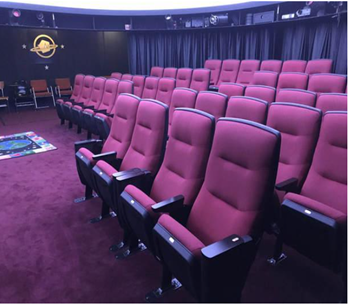Planetarium
HISTORY OF THE HUBBLE PLANETARIUM

Shortly after Edward R. Murrow High School opened in 1974, astronomy teacher Sam Storch turned a regular science classroom, room 490, into the Edwin P. Hubble Planetarium. Opened in 1979, the Hubble Planetarium remains among the last operational sky theaters housed inside a New York City school and serves students taking our Astronomy elective as well as Earth Science classes.
“Instead of naming it after Galileo or Newton, I wanted to name it after an American, someone more contemporary,” explains Storch. “So we named the planetarium after Edwin P. Hubble, even before the telescope was named after him. He’s the American astronomer whose research demonstrated the expansion of the universe.”
Mr. Storch bought a sky projector from Tokyo and spent countless hours soldering wires together. After he retired in 2009, after an astonishing 41 years of teaching, Marc Horowitz took over as Planetarium Director and currently runs Murrow's astronomy program.
RENOVATIONS
 Our facility recently finished undergoing a complete overhaul. We replaced our carpet, seating, ceilings and have a new entrance way to our dome. Interactive student work greets visitors in our vestibule and sets the tone for your Astronomy experience.
Our facility recently finished undergoing a complete overhaul. We replaced our carpet, seating, ceilings and have a new entrance way to our dome. Interactive student work greets visitors in our vestibule and sets the tone for your Astronomy experience.
Dome lighting is an essential part of our visitors’ experience. We installed new computerized LED cove lighting which can create blue skies, theatrical “lighting chases” and a myriad of other schemes. A new sound system has been installed, allowing visitors to be surrounded in realistic sounds and music that is linked to a fully programmable DVD player.
ASTRONOMY ELECTIVE

Our Astronomy course at Murrow is a science elective and runs for a full year. Students may choose Astronomy after fulfilling their Living Environment and Physical Science requirements. Priority for seating is given to Seniors.
Our course covers a myriad of topics including:
- Celestial sphere and orientation with the night sky
- A timeline of Astronomy (or how we got to know what we know)
- Solar system and planetary science
- Our Moon
- The nature of light
- Understanding our Sun
- Stellar evolution
- Bizarre Stellar Objects – White Dwarves, Neutron Stars, Pulsars and Black Holes
- Galaxies – Great Islands of Stars
- Exo-planets and Astrobiology
- Large Scale Structure of the Universe
- Cosmology and our origins – Big Bang and Beyond
In addition, throughout the year, we will discuss NASA missions and the latest discoveries such as the Mars Science Laboratory (Curiosity) and others. There is no Regents Exam in Astronomy and as such our course is mostly project based. Students are expected to bring a strong curiosity to class and develop projects based on their interests.
OPPORTUNITIES:
Edward R. Murrow Students are encouraged to explore all opportunities - with the support of their teachers- that are available to them. One such opportunity was asking Astronaut Chris Cassidy a question while he was in the International Space Station. Our very own Sophia Suarez Class of 2021 was picked to participate, please click the link to watch the event, sponsored by Science News! Sophia can be found at the 13:14 minute mark.
A huge thank you to The Society for Science News and Chris Cassidy for this amazing opportunity!
Please click on the link to find a message from NASA to our 2020 graduates!!
What does the future of the Hubble Planetarium hold?
Speaking of opportunities, our partnership with NASA has provided our students more opportunities and will continue to provide more opportunities. Please click on the link to find out more about our proposed Stephen Hawking Space Science Academy.
HUBBLE PLANETARIUM IN THE NEWS
Our Hubble Planetarium has made its debut in Media….click on the links below for the articles
American Schools and UniversityFor More Information:
CONTACT THE PLANETARIUM DIRECTOROur Partnership
